Orientation Relationship of FeNiC and FeNiCSi from Variant Detection in EBSD Data
Abstract
1. Introduction
2. Experimental Procedure
Code Development
3. Results
4. Discussion
5. Conclusions
- -
- The code contains different modes that can be used for an in-depth analysis of obtained ORs, specifically the automatic, semi-automatic and manual selection of grains or microstructure areas.
- -
- The automatic mode allows a statistically relevant and fully automatic evaluation of the orientation relationship of a large range of grains and thereby allows the determination of the predominant OR. This is done by comparing the pole figures of the corresponding phases of interest, e.g., retained parent austenite grains and the adjacent martensite grains, with a calculated theoretical orientation relationship.
- -
- Additionally, the manual evaluation mode provides local insights into the precise OR for chosen grains or individual interfaces, and in the present case a determination of the occurring martensite variants was possible. The selection of individual measurement points instead of whole grains is also possible, and could be used to evaluate the behavioural impact of intragranular misorientations on the OR or be applied if the indexing rate of the EBSD data is low.
- -
- Exemplarily, the code was applied to an austenitic–martensitic steel where the successful identification and evaluation of the OR between austenite and martensite was demonstrated. The comparison of the misorientation angle distribution with the misorientation angles of specific ORs supports the identification of the Greninger–Troiano OR for both FeNiC and FeNiCSi. This was further confirmed by an image correlation algorithm, comparing calculated theoretical variants with the experimental pole figures.
- -
- For quantitative analysis of the observed OR, the minimum rotation angle deviations between the experimental and the theoretically calculated orientation relationships were determined for different ORs. This method was successfully applied to confirm the previously identified Greninger–Troiano OR for the present example case.
- -
- Although the capabilities of the developed code on the example of martensite and austenite in steels have been demonstrated, it can be used for many other applications where an orientation relationship between different phases is relevant. An adaptation of the present method for the investigation of ORs in other material systems, such as intermetallic phases, shape memory alloys, thin films or other composite materials, could provide insights into the existing ORs.
Author Contributions
Funding
Data Availability Statement
Acknowledgments
Conflicts of Interest
References
- Asghari-Rad, P.; Nili-Ahmadabadi, M.; Shirazi, H.; Hossein Nedjad, S.; Koldorf, S. A significant improvement in the mechanical properties of AISI 304 stainless steel by a combined RCSR and annealing process: A significant improvement in the mechanical properties. Adv. Eng. Mater. 2016, 19, 1600663. [Google Scholar] [CrossRef]
- Ren, J.; Li, C.; Han, Y.; Li, E.; Gao, C.; Qiu, C. Effect of initial martensite and tempered carbide on mechanical properties of 3Cr2MnNiMo mold steel. Mater. Sci. Eng. A 2021, 812, 141080. [Google Scholar] [CrossRef]
- Ameyama, K.; Weatherly, G.; Aust, K. A study of grain boundary nucleated widmanstätten precipitates in a two-phase stainless steel. Acta Metall. Mater. 1992, 40, 1835–1846. [Google Scholar] [CrossRef]
- Chen, T.H.; Yang, J.-R. Microstructural characterization of simulated heat affected zone in a nitrogen-containing 2205 duplex stainless steel. Mater. Sci. Eng. A 2002, 338, 166–181. [Google Scholar] [CrossRef]
- Shek, C.H.; Lai, J.K.L.; Wong, K.W.; Dong, C. Early-stage widmanstatten growth of the γ phase in a duplex steel. Met. Mater. Trans. A 2000, 31, 15–19. [Google Scholar] [CrossRef]
- Shtansky, D.V.; Nakai, K.; Ohmori, Y. Crystallography and structural evolution during reverse transformation in an Fe–17Cr–0.5C tempered martensite. Acta Mater. 2000, 48, 1679–1689. [Google Scholar] [CrossRef]
- Zhang, M.-X.; Kelly, P. Accurate orientation relationship between ferrite and austenite in low carbon martensite and granular bainite. Scr. Mater. 2002, 47, 749–755. [Google Scholar] [CrossRef]
- Brückner, G.; Pospiech, J.; Seidl, I.; Gottstein, G. Orientation correlation during diffusional α→γ phase transformation in a ferritic low carbon steel. Scr. Mater. 2001, 44, 2635–2640. [Google Scholar] [CrossRef]
- Bugat, S.; Besson, J.; Gourgues, A.-F.; N’Guyen, F.; Pineau, A. Microstructure and damage initiation in duplex stainless steels. Mater. Sci. Eng. A 2001, 317, 32–36. [Google Scholar] [CrossRef]
- Gourgues, A.-F.; Flower, H.M.; Lindley, T.C. Electron backscattering diffraction study of acicular ferrite, bainite, and martensite steel microstructures. Mater. Sci. Technol. 2000, 16, 26–40. [Google Scholar] [CrossRef]
- Morito, S.; Tanaka, H.; Konishi, R.; Furuhara, T.; Maki, T. The morphology and crystallography of lath martensite in Fe-C alloys. Acta Mater. 2003, 51, 1789–1799. [Google Scholar] [CrossRef]
- Suh, D.-W.; Kang, J.-H.; Oh, K.H.; Lee, H.-C. Evaluation of the deviation angle of ferrite from the Kudjumov–Sachs relationship in a low carbon steel by EBSD. Scr. Mater. 2002, 46, 375–378. [Google Scholar] [CrossRef]
- Ueda, M.; Yasuda, H.; Umakoshi, Y. Stress-induced martensitic transformation in Fe–Ni bicrystals. Acta Mater. 2001, 49, 4251–4258. [Google Scholar] [CrossRef]
- Sato, H.; Zaefferer, S. A study on the formation mechanisms of butterfly-type martensite in Fe–30% Ni alloy using EBSD-based orientation microscopy. Acta Mater. 2009, 57, 1931–1937. [Google Scholar] [CrossRef]
- Shibata, A.; Morito, S.; Furuhara, T.; Maki, T. Local orientation change inside lenticular martensite plate in Fe–33Ni alloy. Scr. Mater. 2005, 53, 597–602. [Google Scholar] [CrossRef]
- Yardley, V.; Payton, E. Austenite–martensite/bainite orientation relationship: Characterisation parameters and their application. Mater. Sci. Technol. 2014, 30, 1125–1130. [Google Scholar] [CrossRef]
- Brodusch, N.; Demers, H.; Gauvin, R. Nanometres-resolution Kikuchi patterns from materials science specimens with transmission electron forward scatter diffraction in the scanning electron microscope. J. Microsc. 2013, 250, 2635–2640. [Google Scholar] [CrossRef]
- Nolze, G. Determination of Orientation Relationships between Fcc/Bcc Lattices by the Use of Pole Figures; HKL Usermeeting: Ribe, Denmark, 2004; pp. 1–9. [Google Scholar]
- Nishiyama, Z. Science Reports of Tohoku Imperial University Tokyo; University of Tokyo: Tokyo, Japan, 1934; Volume 23, pp. 637–664. [Google Scholar]
- Wassermann, G. Über den Mechanismus der Alpha-Gamma-Umwandlung des Eisens; Stahleisen: Düsseldorf, Germany, 1935. [Google Scholar]
- Kurdjumow, G.; Sachs, G. Über den Mechanismus der Stahlhärtung. Z. Phys. 1930, 64, 325–343. [Google Scholar] [CrossRef]
- Gardiola, B.; Esling, C.; Humbert, M.; Hensger, K.E. EBSD Study of the γ to α phase transormation in an CSP–HSLA Steel. Adv. Eng. Mater. 2003, 5, 583–586. [Google Scholar] [CrossRef]
- Maki, T. Microstructure and mechanical behaviour of ferrous martensite. In Materials Science Forum; Trans Tech Publications Ltd.: Zurich, Switzerland, 1990. [Google Scholar]
- Umemoto, M.; Yoshitake, E.; Tamura, I. The morphology of martensite in Fe-C, Fe-Ni-C and Fe-Cr-C alloys. J. Mater. Sci. 1983, 18, 2893–2904. [Google Scholar] [CrossRef]
- Maki, T.; Shimooka, S.; Umemoto, M.; Tamura, I. The Morphology of Strain-Induced Martensite and Thermally Transformed Martensite in Fe–Ni–C Alloys. Trans. Jpn. Inst. Met. 1972, 13, 400–407. [Google Scholar] [CrossRef]
- Maki, T.; Wayman, C. Effect of coherent precipitates in austenite on the martensite substructure in an Fe-Ni-Ti-C alloy. Acta Met. 1977, 25, 695–710. [Google Scholar] [CrossRef]
- Nishiyama, Z.; Shimizu, K.; Sugino, K. The martensite transformation in thin foils. Acta Met. 1961, 9, 620–622. [Google Scholar] [CrossRef]
- Sun, D.; Guo, Z.; Gu, J. The microstructure and crystallography of lath martensite with Greninger-Troiano orientation relationship in a Fe-12.8Ni-1.5Si-0.22%C steel. Mater. Charact. 2021, 181, 111501. [Google Scholar] [CrossRef]
- Sun, D.; Li, C.; Xue, X.; Liu, Y.; Guo, Z.; Gu, J. Optimization scheme of the orientation relationship from crystallographic statistics of variants and its application to lath martensite. Mater. Des. 2020, 195, 109022. [Google Scholar] [CrossRef]
- Wang, C.; Qiu, H.; Kimura, Y.; Inoue, T. Morphology, crystallography, and crack paths of tempered lath martensite in a medium-carbon low-alloy steel. Mater. Sci. Eng. A 2016, 669, 48–57. [Google Scholar] [CrossRef]
- Koumatos, K.; Muehlemann, A. A theoretical investigation of orientation relationships and transformation strains in steels. Acta Crystallogr. Sect. A Found. Adv. 2017, 73, 115–123. [Google Scholar] [CrossRef]
- Pitsch, W. The martensite transformation in thin foils of iron-nitrogen alloys. Philos. Mag. A J. Theor. Exp. Appl. Phys. 1959, 4, 577–584. [Google Scholar] [CrossRef]
- Greninger, A.B.; Troiano, A.R. The mechanism of Martensite formation. JOM 1949, 1, 590–598. [Google Scholar] [CrossRef]
- Shibata, A.; Murakami, T.; Morito, S.; Furuhara, T.; Maki, T. The Origin of Midrib in Lenticular Martensite. Mater. Trans. 2008, 49, 1242–1248. [Google Scholar] [CrossRef]
- Mola, J.; Luan, G.; Brochnow, D.; Volkova, O.; Wu, J. Tempering of Martensite and Subsequent Redistribution of Cr, Mn, Ni, Mo, and Si Between Cementite and Martensite Studied by Magnetic Measurements. Met. Mater. Trans. A 2017, 48, 5805–5812. [Google Scholar] [CrossRef]
- Scheer, L. Was ist Stahl?: Einführung in die Stahlkunde für Jedermann; Springer: Berlin, Germany, 2013. [Google Scholar]
- Sherman, D.H.; Cross, S.M.; Kim, S.; Grandjean, F.; Long, G.J.; Miller, M.K. Characterization of the Carbon and Retained Austenite Distributions in Martensitic Medium Carbon, High Silicon Steel. Metall. Mater. Trans. A 2007, 38, 1698–1711. [Google Scholar] [CrossRef]
- Bachmann, F.; Hielscher, R.; Schaeben, H. Texture Analysis with MTEX—Free and Open Source Software Toolbox. Solid State Phenom. 2010, 160, 63–68. [Google Scholar] [CrossRef]
- Seehaus, M.; Pei, R. ORs from EBSD. 2022. Available online: https://github.com/Mattis-Seehaus/ORs_from_EBSD (accessed on 31 July 2022).
- Verbeken, K.; Barbé, L.; Raabe, D. Evaluation of the crystallographic orientation relationships between FCC and BCC phases in TRIP steels. ISIJ Int. 2009, 49, 1601–1609. [Google Scholar] [CrossRef]
- Haralick, R.M.; Shapiro, L.G. Computer and Robot Vision; Addison-Wesley Reading: Boston, MA, USA, 1992; Volume 1. [Google Scholar]
- Lewis, J. Fast Normalized Cross-Correlation 1995; Industrial Light & Magic: San Francisco, CA, USA, 2011. [Google Scholar]
- Buchheit, T.E.; Wert, J.A. Predicting the orientation-dependent stress-induced transformation and detwinning response of shape memory alloy single crystals. Metall. Mater. Trans. A 1996, 27, 269–279. [Google Scholar] [CrossRef]
- Nishida, M.; Nishiura, T.; Kawano, H.; Inamura, T. Self-accommodation of B19’ martensite in Ti–Ni shape memory alloys—Part I. Morphological and crystallographic studies of the variant selection rule. Philos. Mag. 2012, 92, 2215–2233. [Google Scholar] [CrossRef]
- Lv, S.; Lu, X.; Li, Y.; Meng, F.; Hua, X.; Yang, Q.; Qiu, X.; Meng, J.; Duan, Q. Crystallographic orientation relationships between the aggregated intermetallic phases in a casting Mg-Ag-Al alloy. Mater. Des. 2020, 190, 108561. [Google Scholar] [CrossRef]
- Miyamoto, G.; Takayama, N.; Furuhara, T. Accurate measurement of the orientation relationship of lath martensite and bainite by electron backscatter diffraction analysis. Scr. Mater. 2009, 60, 1113–1116. [Google Scholar] [CrossRef]
- Kinney, C.C.; Pytlewski, K.R.; Khachaturyan, A.G.; Morris, J.W., Jr. The microstructure of lath martensite in quenched 9Ni steel. Acta Mater. 2014, 69, 372–385. [Google Scholar] [CrossRef]
- Thome, P.; Schneider, M.; Yardley, V.A.; Payton, E.J.; Eggeler, G. Crystallographic Analysis of Plate and Lath Martensite in Fe-Ni Alloys. Crystals 2022, 12, 156. [Google Scholar] [CrossRef]
- Jafarian, H.R.; Borhani, E.; Shibata, A.; Terada, D.; Tsuji, N. Martensite/austenite interfaces in ultrafine grained Fe–Ni–C alloy. J. Mater. Sci. 2011, 46, 4216–4220. [Google Scholar] [CrossRef]
- Zilnyk, K.; Junior, D.R.D.A.; Sandim, H.; Rios, P.; Raabe, D. Misorientation distribution between martensite and austenite in Fe-31 wt%Ni-0.01 wt%C. Acta Mater. 2017, 143, 227–236. [Google Scholar] [CrossRef]
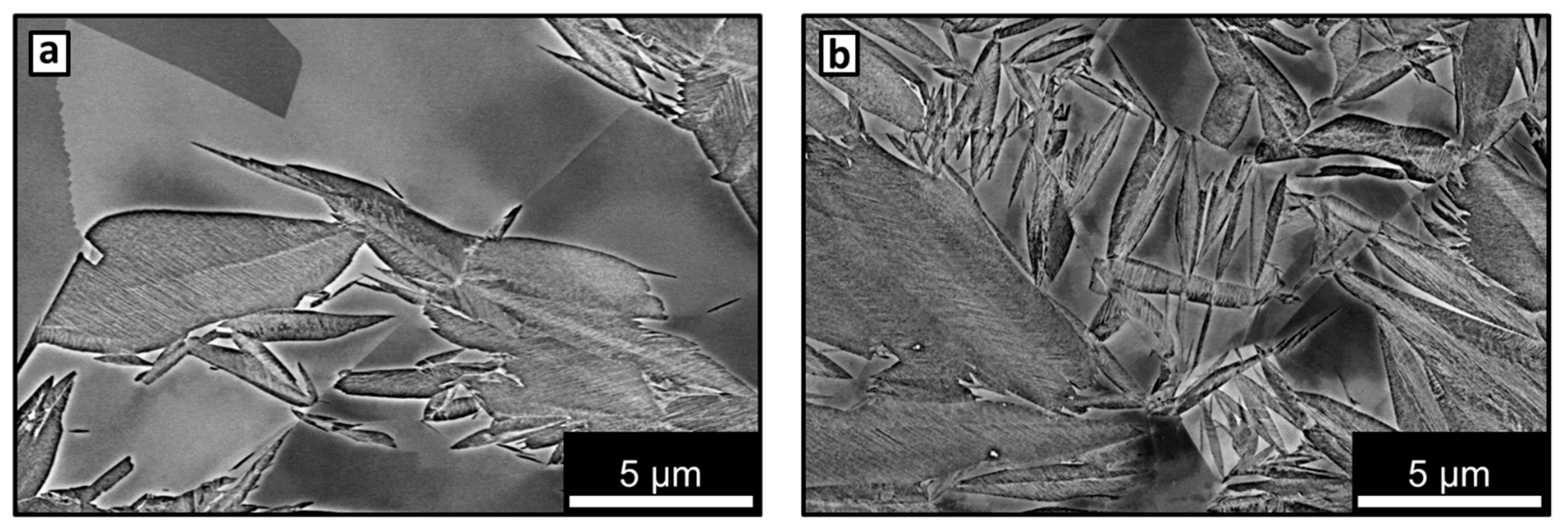
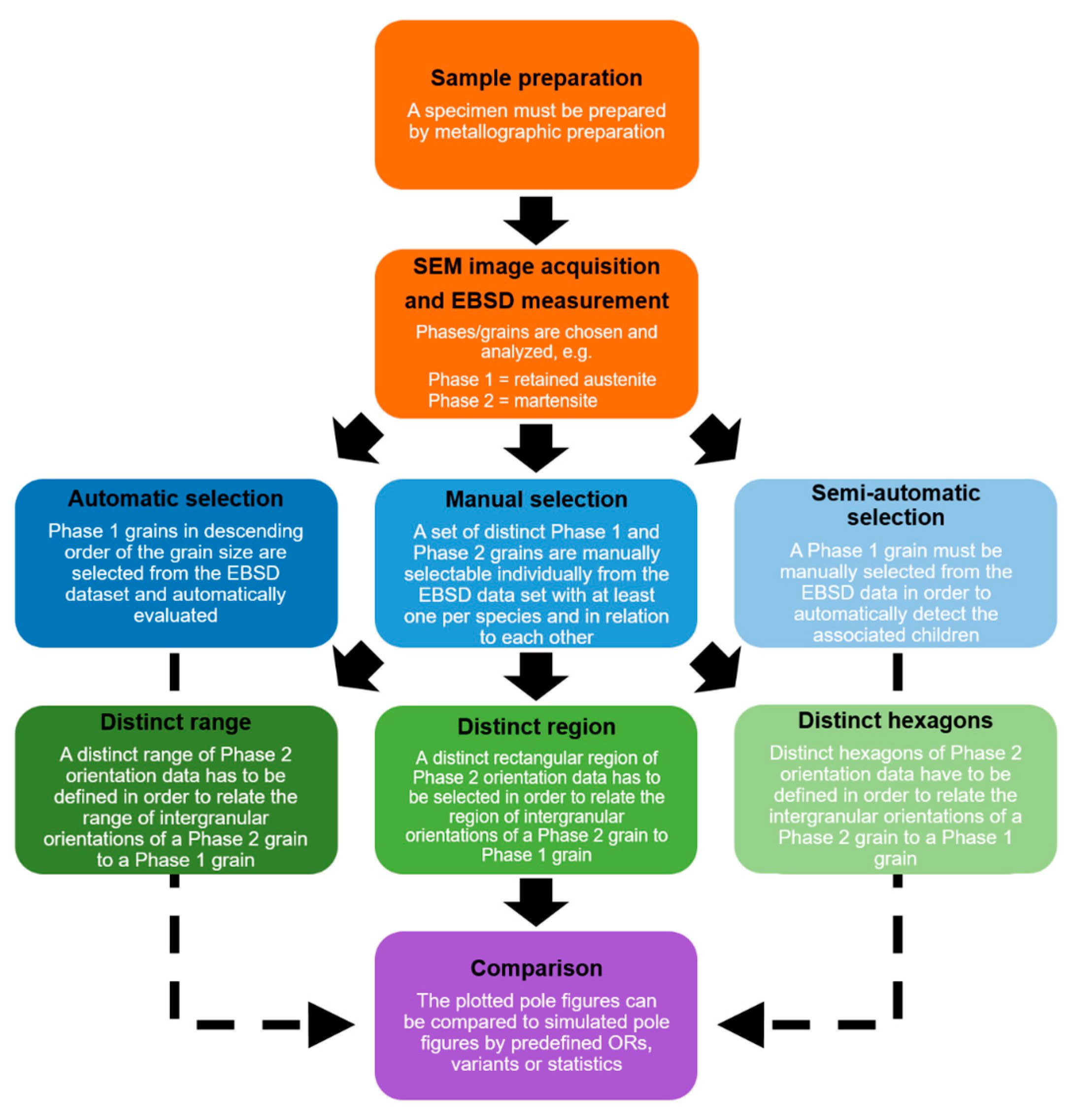



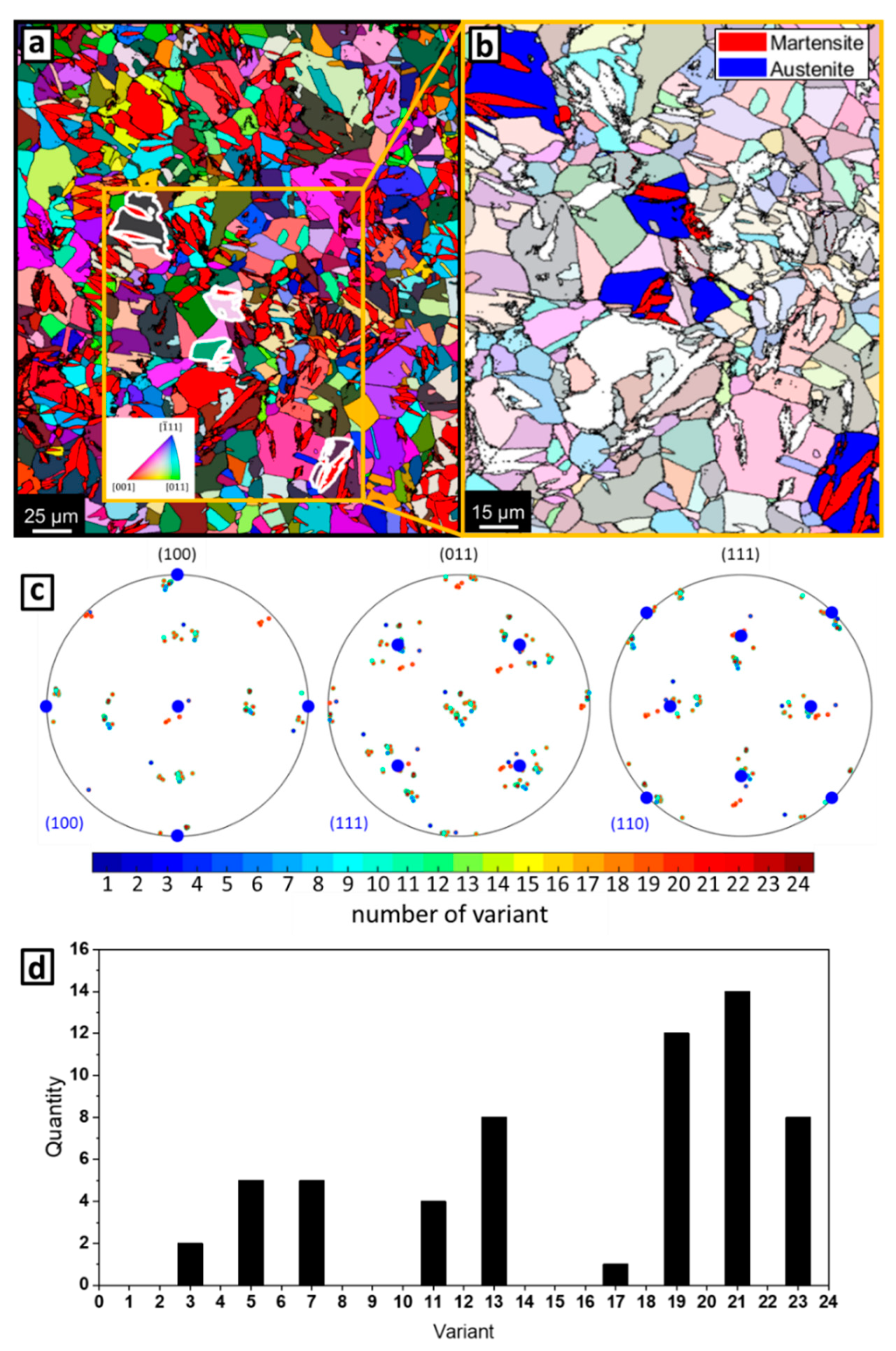
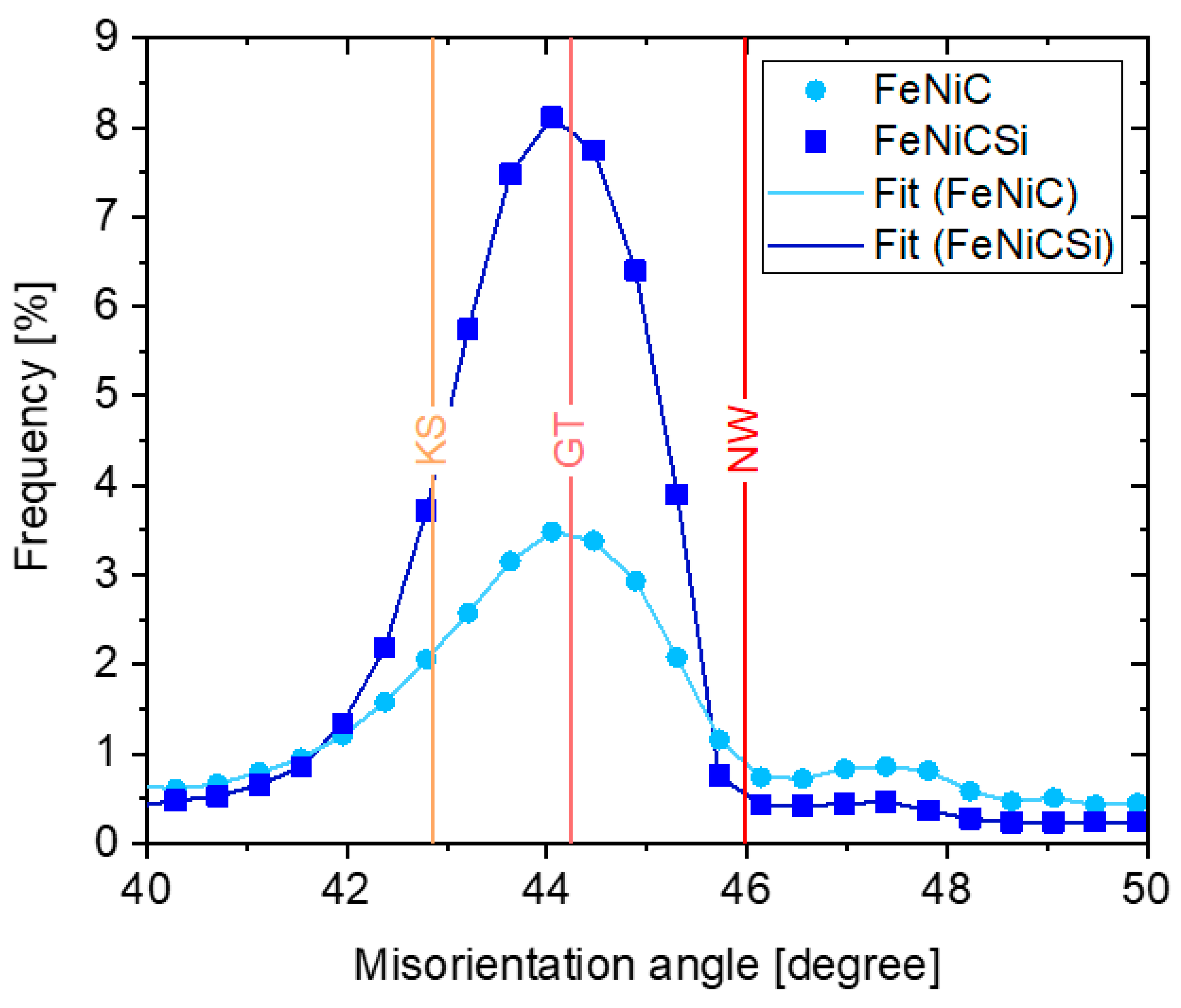
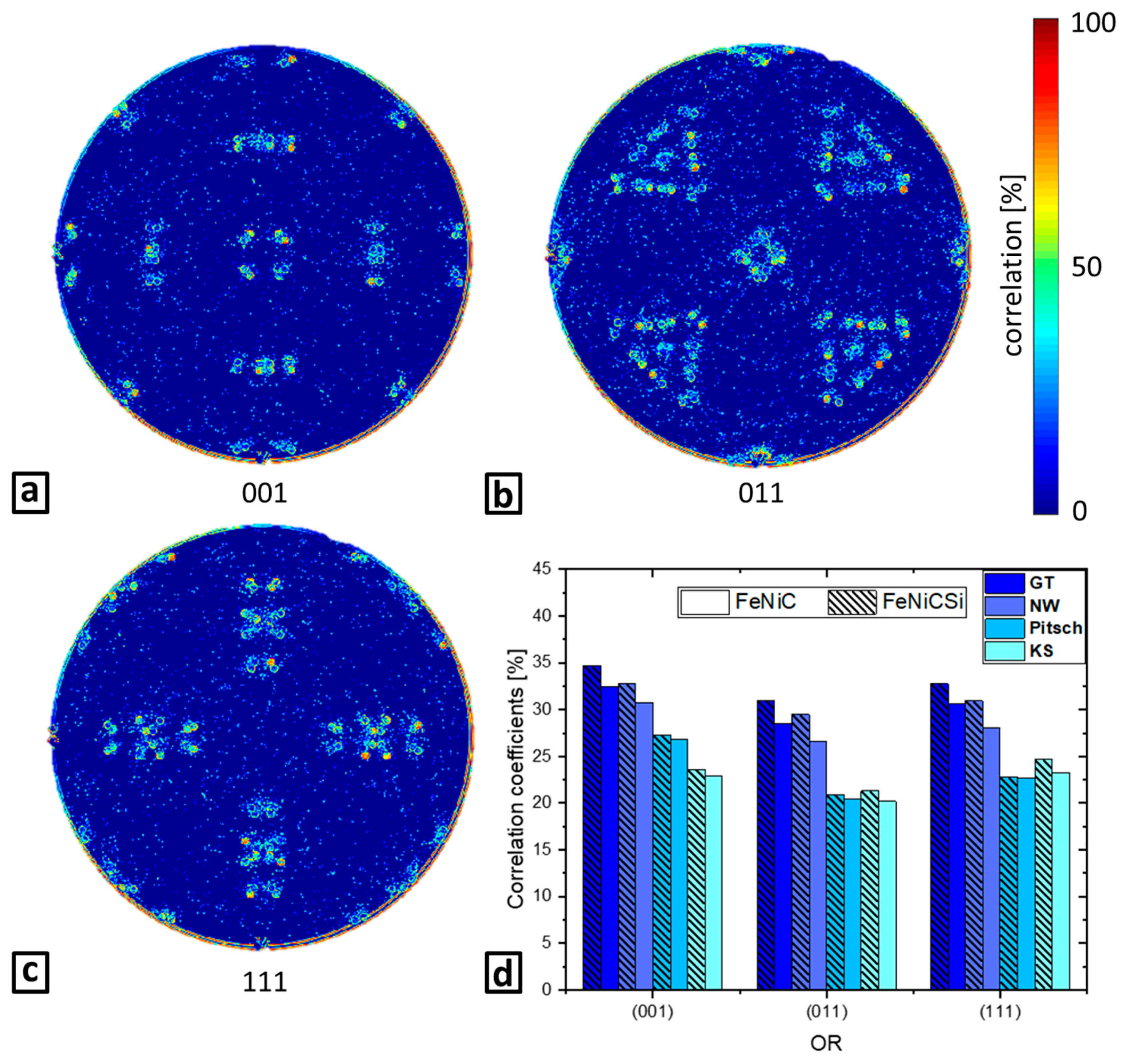
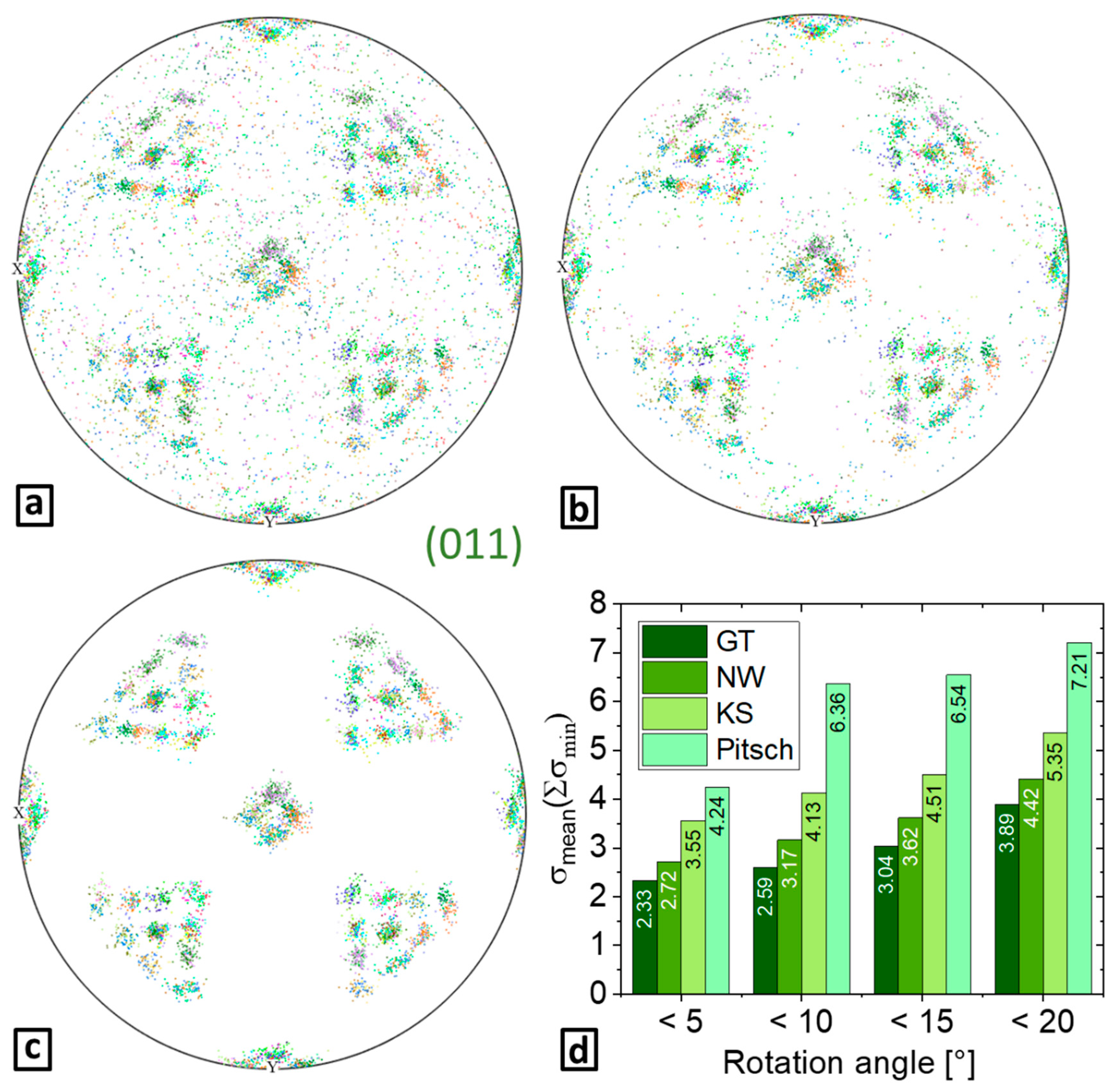
| OR | Plane | Direction |
|---|---|---|
| Bain | {100} γ//{100}α | <100> γ//<110> α |
| NW | {111} γ//{110} α | <112> γ//<110> α |
| KS | {111} γ//{110} α | <110> γ//<111> α |
| GT | {111} γ//{110} α | <123> γ//<133> α |
| Pitsch | {100} γ//{110} α | <110> γ//<111> α |
| Variant No. | Mis. Angle from V1 | Rotation Axis from V1 | φ1 | Φ | φ2 |
|---|---|---|---|---|---|
| 1 | 0 | - | 324.79 | 170.10 | 191.32 |
| 2 | 55.26 | [−0.71 0.00 0.71] | 98.12 | 84.31 | 136.13 |
| 3 | 60 | [−0.71 0.00 0.71] | 351.88 | 95.70 | 316.13 |
| 4 | 4.74 | [−0.71 0.00 0.71] | 125.21 | 9.90 | 11.32 |
| 5 | 60 | [−0.71 0.00 0.71] | 275.75 | 98.08 | 46.94 |
| 6 | 60.25 | [−0.53 0.53 0.66] | 174.25 | 81.92 | 226.94 |
| 7 | 50.67 | [−0.64 0.42 0.64] | 261.88 | 95.70 | 316.13 |
| 8 | 16.61 | [−0.69 0.23 0.69] | 35.21 | 9.90 | 11.32 |
| 9 | 55.24 | [−0.67 0.23 0.71] | 185.75 | 98.08 | 46.94 |
| 10 | 50.14 | [−0.47 0.57 0.68] | 84.25 | 81.92 | 226.94 |
| 11 | 13.99 | [−0.55 0.06 0.83] | 234.79 | 170.10 | 191.32 |
| 12 | 50.65 | [−0.67 0.26 0.70] | 8.12 | 84.31 | 136.13 |
| 13 | 13.99 | [−0.06 0.55 0.83] | 54.79 | 170.10 | 191.32 |
| 14 | 50.14 | [−0.57 0.47 0.68] | 188.11 | 84.31 | 136.13 |
| 15 | 52.21 | [−0.21 0.65 0.73] | 81.88 | 95.70 | 316.13 |
| 16 | 11.60 | [−0.69 0.19 0.69] | 215.21 | 9.90 | 11.32 |
| 17 | 49.64 | [−0.60 0.52 0.60] | 5.75 | 98.08 | 46.94 |
| 18 | 56.85 | [−0.19 0.66 0.72] | 264.25 | 81.92 | 226.94 |
| 19 | 55.24 | [−0.23 0.67 0.71] | 354.25 | 81.92 | 226.94 |
| 20 | 50.65 | [−0.26 0.67 0.70] | 95.75 | 98.08 | 46.94 |
| 21 | 19.71 | [−0.14 0.00 0.99] | 305.21 | 9.90 | 11.32 |
| 22 | 56.84 | [−0.66 0.19 0.72] | 171.88 | 95.69 | 316.13 |
| 23 | 52.21 | [−0.65 0.21 0.73] | 278.11 | 84.31 | 136.13 |
| 24 | 19.80 | [−0.20 0.00 0.98] | 144.79 | 170.10 | 191.32 |
| OR | <uvw> | ωmin |
|---|---|---|
| Bain | <100> | 45° |
| NW | <0.98 0.08 0.20> | 45.98° |
| KS | <0.97 0.18 0.18> | 42.85° |
| GT | <0.97 0.19 0.13> | 44.23° |
| Pitsch | <0.08 0.20 0.98> | 45.98° |
| OR | NW | KS | GT | Pitsch |
|---|---|---|---|---|
| Mean Ccorr (FeNiC) | 28.50 | 24.05 | 30.51 | 23.33 |
| Mean Ccorr (FeNiCSi) | 31.05 | 25.41 | 32.84 | 23.66 |
| Mean σ (FeNiC) [°] | 3.48 | 4.39 | 2.97 | 6.09 |
| Mean σ (FeNiCSi) [°] | 3.70 | 4.54 | 3.12 | 6.04 |
Disclaimer/Publisher’s Note: The statements, opinions and data contained in all publications are solely those of the individual author(s) and contributor(s) and not of MDPI and/or the editor(s). MDPI and/or the editor(s) disclaim responsibility for any injury to people or property resulting from any ideas, methods, instructions or products referred to in the content. |
© 2023 by the authors. Licensee MDPI, Basel, Switzerland. This article is an open access article distributed under the terms and conditions of the Creative Commons Attribution (CC BY) license (https://creativecommons.org/licenses/by/4.0/).
Share and Cite
Seehaus, M.; Pei, R.; Korte-Kerzel, S.; Sandlöbes-Haut, S. Orientation Relationship of FeNiC and FeNiCSi from Variant Detection in EBSD Data. Crystals 2023, 13, 663. https://doi.org/10.3390/cryst13040663
Seehaus M, Pei R, Korte-Kerzel S, Sandlöbes-Haut S. Orientation Relationship of FeNiC and FeNiCSi from Variant Detection in EBSD Data. Crystals. 2023; 13(4):663. https://doi.org/10.3390/cryst13040663
Chicago/Turabian StyleSeehaus, Mattis, Risheng Pei, Sandra Korte-Kerzel, and Stefanie Sandlöbes-Haut. 2023. "Orientation Relationship of FeNiC and FeNiCSi from Variant Detection in EBSD Data" Crystals 13, no. 4: 663. https://doi.org/10.3390/cryst13040663
APA StyleSeehaus, M., Pei, R., Korte-Kerzel, S., & Sandlöbes-Haut, S. (2023). Orientation Relationship of FeNiC and FeNiCSi from Variant Detection in EBSD Data. Crystals, 13(4), 663. https://doi.org/10.3390/cryst13040663







